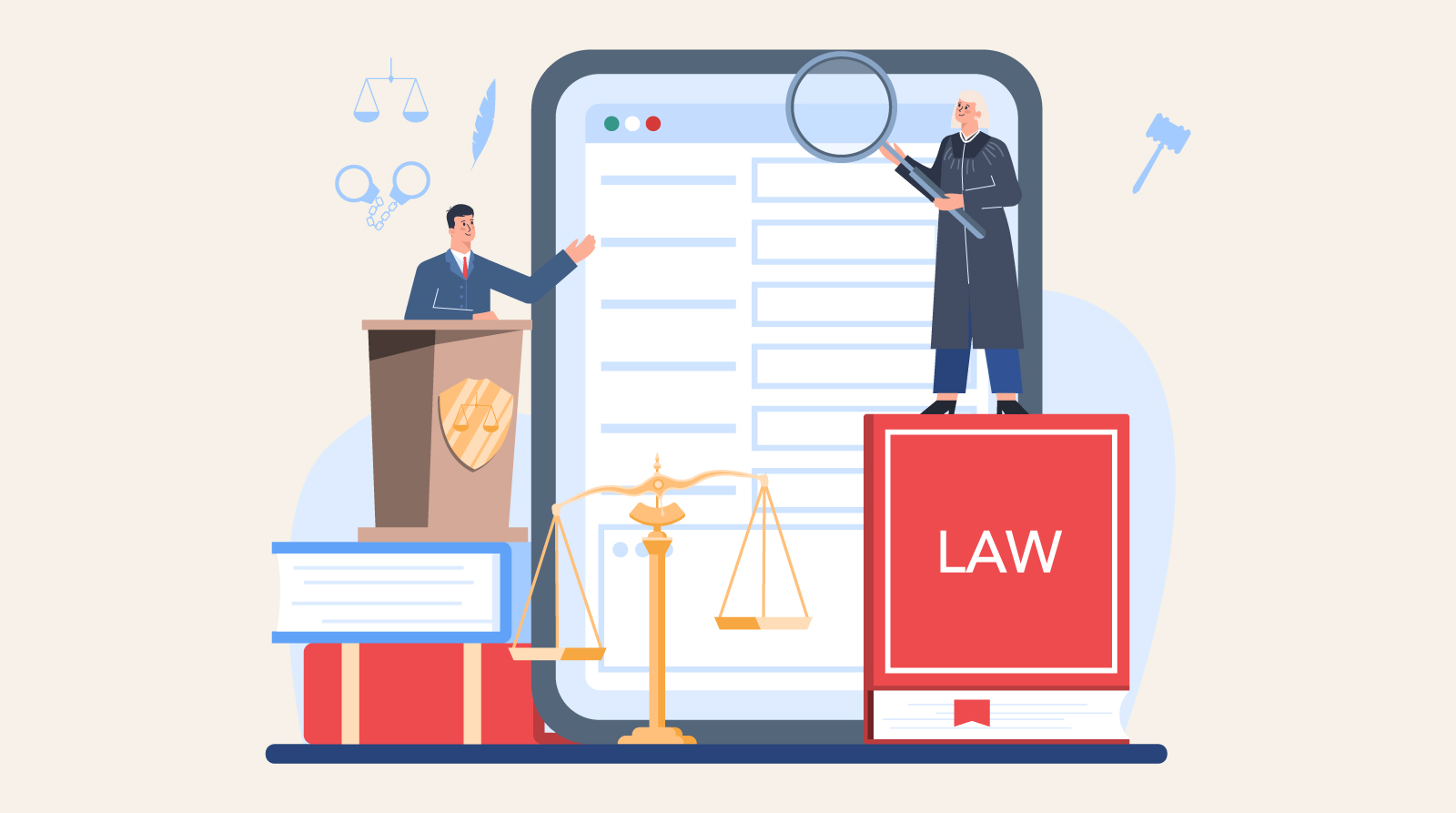Features of Legal Websites: A Complete Guide for 2025

As a lawyer, think of your website as your digital storefront.
It’s your first chance to make a great impression, so your lawyer website must include the best features, like easy navigation and secure client portals.
Today’s clients expect more than just a simple list of services; they want a smooth, secure, and helpful experience from start to finish.
In this article, I’ll discuss the key features every lawyer website should have to improve user experience, build trust, and convert visitors into clients.
What Are the Essential Features of Legal Websites?
1. Rapid Page Loading
Of course, you don't want someone visiting your site, waiting a few seconds… and then giving up.
That’s why fast loading is one of the most important legal website features you can have.
People just don’t have the patience anymore.
According to Google, if your site takes more than three seconds to load, most visitors will leave without even giving you a chance.
For law firms—especially in busy places like Austin, TX—speed isn’t just a bonus, it’s survival.
Even the best-designed lawyer websites don’t stand a chance if clients never get far enough to see what’s on them.
And if you have secure client portals, slow loading can make clients second-guess how reliable your firm really is.
Here’s how law firms can make their sites faster:
Use compressed images to keep file sizes small
Cut back on unnecessary scripts and plugins
Turn on browser caching and lazy loading
Pick a strong hosting provider with fast servers
Set up a Content Delivery Network (CDN) to speed things up worldwideCheck your speed regularly with tools like Google PageSpeed Insights
Get rid of unnecessary redirects and fix slow server responses
Clean up your CSS and JavaScript by minifying the code
Make sure your hosting plan can handle traffic spikes without slowing down
When a site loads fast, visitors are much more likely to stick around, browse services, or log into secure client portals without any hiccups.
Speed also gives you a big boost with SEO.
Google favors faster lawyer websites when it ranks pages, so it’s a win-win: better user experience and better visibility.
2. Robust Security & Privacy Measures
Imagine this: Your law firm’s website is a digital vault, and every client’s personal information is locked safely inside.
Sounds pretty vital, right?
Well, in the world of legal website features, security is that vault—and it needs to be built with care.
When handling sensitive client data, a breach can be more than a security issue; it’s a threat to trust, credibility, and even your firm's future.
Here’s why security is your firm’s best friend:
Protecting Client Data: Clients come to you with their most confidential information. A secure website is like an impenetrable fortress, keeping hackers and cybercriminals from getting their hands on anything private.
Maintaining Client Trust: Think of it this way—clients who feel safe online are far more likely to stick around, use your secure client portals, and trust you with their legal needs.
Avoiding Legal Trouble: It’s not just about trust—it’s about compliance. If a breach happens, the consequences can be severe, from legal penalties to reputational damage.
Now, let’s talk compliance.
To ensure your website isn’t just secure but also in line with the rules, you’ll need to:
Follow Data Protection Laws like GDPR and any local regulations that apply to your practice area.
Honor Ethical Obligations set by the legal industry, making sure your site respects client confidentiality at all times.
Stay aware of Industry-Specific Regulations that apply to the legal world in your region or niche.
To lock down your site, here are some must-do security measures:
Install an SSL certificate to encrypt all data transfer
Keep your website updated regularly to fight off new threats
Enforce strong password policies for any login areas
Encrypt sensitive data stored on your site
Set up automated backups so your data is always safe
Train your team on security best practices

3. Comprehensive Accessibility Compliance
Say you’ve got a website that’s sleek, professional, and ready to attract clients.
But wait—what about those who might need a little extra help to navigate?
It's time to consider accessibility, and not just because it’s the right thing to do, but because it opens your firm to a whole new audience.
As a Title III business, your law firm falls under the umbrella of businesses that serve the public, meaning you must follow ADA (Americans with Disabilities Act) compliance standards.
Simply put, if your website isn’t accessible to people with disabilities, you might be in for a lawsuit.
And no one wants to be that lawyer who’s getting sued because their website wasn’t up to code.
So, what does ADA compliance mean for your law firm?
It’s the Right Thing to Do: Around 13% of Americans live with some form of disability, and they deserve equal access to legal services. When your website is ADA-compliant, you're offering help to a larger audience, ensuring your law firm is available to everyone.
It’s Just Good Business: Accessibility isn’t just a nice-to-have feature—it’s smart business. By making your website easy to use for people with disabilities, you’re not only following the law, but you're also tapping into an underserved market that can benefit from your expertise.
Hiring a website design firm that specializes in ADA compliance is a wise move.
These experts know the ins and outs of ensuring your website follows all the rules.
For example, you’ll need to:
Ensure your site is navigable by keyboard for those who can’t use a mouse
Provide alternative text for images so screen readers can describe them
Make sure that videos have captions for the hearing-impaired
Offer high-contrast colors for better visibility
Test regularly to make sure all elements are accessible
4. Intuitive User Interface
No one wants to deal with a cluttered, confusing lawyer website when they're already juggling tough legal issues.
Your legal website features should act as a friendly guide, not a maze to navigate.
Imagine landing on a page where the menu is so clear that you can immediately find the practice areas, attorney bios, or contact info.
Bold buttons like “Book a Consultation” or “Access secure client portals” catch your eye, helping you smoothly move to the next step.
To make the experience even better, there’s plenty of space so things don’t feel cramped, and big, easy-to-read headlines help you focus on what matters most.
And with over half of all searches happening on mobile devices, your website must adjust seamlessly to any screen size, ensuring it looks great and functions smoothly no matter what device someone’s using.
The design also incorporates smart color choices and simple, professional fonts that help build trust.
Plus, just the right amount of high-quality images makes the page visually engaging without overwhelming it.
Small visual dividers help break up the content, guiding your eyes naturally through the information.
When all of these elements come together in a user-first design, visitors feel cared for from the moment they arrive, making it easy and stress-free to reach out to your firm.
5. Built-In Live Chat & Inquiry Forms
A lot of times, clients aren’t sure what to ask or how fast they’ll get a response.
Adding a live chat widget to your lawyer websites gives them instant help, so they don’t have to sit around waiting.
This immediate support keeps visitors on your site longer, giving you more chances to turn them into clients.
Plus, by tracking common questions, you can improve your content and customer service over time.
Sometimes, clients need a little more information, and that's where a simple inquiry form comes in handy.
Keep it short—just name, email, and a quick description of their legal issue.
Make sure the fields are clearly labeled so it’s easy for them to fill out.
Don’t forget to reassure visitors that their information is secure with a brief privacy note, and provide a confirmation message so they know their request was received.
While automation can save time, a personal touch still matters.
Use your chat widget to send automated greetings and answers to common questions, but always give clients an easy way to talk to a real person, whether that’s through a quick follow-up call or a live handoff in chat.
And when clients fill out the inquiry form, use that info to send personalized follow-up emails that address their specific concerns.
To ensure clients never miss these features, place the live chat and inquiry forms prominently, like next to your phone number in the header.
Also, include each attorney’s email on their profile page.
If your chat leads straight to secure client portals, even better—it makes it easy for clients to share documents and get updates safely.
6. Clear, Concise Service Overviews
Let’s put ourselves in the client’s shoes for a second—they’re likely feeling stressed and need help fast.
Saying a business owner facing a tax audit, they don’t need just any lawyer—they need a tax lawyer with experience in the U.S. Tax Court.
That’s where your lawyer website comes in.
It should make it easy for them to find exactly what they need, without any hassle.
Your site should include a page that clearly outlines the services you offer, using simple, easy-to-understand language.
Avoid the legal jargon that might just confuse them more.
A drop-down menu is a great way to help clients find the exact service they’re looking for in just a few clicks.
The idea is to make their experience smooth and straightforward, so they feel at ease right away.
Also, make sure your main menu links to key pages, like attorney bios, practice areas, and contact info.
You can even use the sidebar to highlight related blog posts or other helpful pages.
This ensures visitors can quickly find the info they need without feeling like they’re wandering around a maze.

7. Dedicated Practice Area Sections
Imagine walking into a huge library where none of the shelves are labeled—you’d feel lost, right?
That’s exactly how clients feel when they land on a lawyer's website without clear practice area sections.
Legal website features shine when each service area acts like a bright signpost, guiding visitors straight to what they need.
Think of each practice area page as its mini-story: Start with a quick, friendly overview that feels like a welcome note rather than a legal lecture.
Use simple, down-to-earth language—no jargon overload—so someone facing a stress-filled situation can instantly know you “get” their problem.
Next, organize your “chapters” so they flow naturally. Group similar services under broad headings—like “Business Law,” “Family Matters,” or “Tax Disputes”—and keep your page layouts consistent so readers don’t have to relearn your menu each time.
Toss in a handy search bar for anyone who wants to zip right to “Estate Planning” or “U.S. Tax Court Defense.”
But don’t stop there.
Sprinkle in real-life victories—short, punchy case studies that show how you’ve helped clients just like them.
These quick success stories act like friendly nods: “Yep, we’ve handled that exact issue, and here’s how we made it work.”
They bring your expertise to life and build trust in a heartbeat.
Finally, weave in easy internal links—like stepping stones—from each practice area to relevant attorney bios or your secure client portals.
This little touch turns curiosity into action, making it simple for someone to go from reading about your services to connecting directly with the right lawyer.
8. Detailed Attorney Profile Pages
You know how, when you meet someone new, you want more than just their job title?
Attorney bios on lawyer websites work the same way.
They’re your chance to introduce each lawyer as a real person, not just a list of degrees.
Start by weaving in the essentials—education, years in practice, standout cases, and any awards—into a short, easy-to-read story.
Skip the heavy legal jargon; just explain how their background makes them the right fit for your needs.
Then, sprinkle in a few personal details—maybe they coach youth soccer on weekends or volunteer at the animal shelter.
Those little tidbits make them relatable and help clients feel an immediate connection.
Keep all profiles looking the same so visitors know what to expect:
A friendly headshot up top
A one-line headline stating their specialty
A brief paragraph bio that tells their story
Quick bullet points for facts like education, bar admissions, and languages spoken
Finally, don’t make people hunt for how to reach out.
Add a clear button—“Connect via secure client portals”—right on the profile so visitors can easily start a chat, send documents, or book a call.
9. Genuine Client Testimonials & Reviews
People trust people.
Not billboards. Not glossy slogans. Real, human stories.
And that’s exactly why client testimonials and reviews are the hidden heartbeat of a great law firm website.
Imagine this: A visitor lands on your site.
They're nervous.
They're about to make a huge decision—one that could change their life.
They're not looking for big promises; they’re looking for proof.
Proof that you’ve stood by people like them and helped them through the storm.
That’s where testimonials step in.
A heartfelt review from a grateful client speaks louder than a thousand ad campaigns.
It shows that you’re not just skilled—you’re trusted.
But here’s the thing: authenticity is everything.
You can’t just sprinkle a few polished quotes and call it a day.
Real trust comes from real stories.
So always:
Get permission before sharing anything.
Respect privacy (some clients might prefer you use their initials or no names at all).
Keep their words raw and honest—no editing to make them sound "perfect."
Match testimonials to the right pages (litigation wins on litigation pages, family law successes on family law pages, and so on).
And don’t let your testimonial wall gather dust!
Update it often with fresh voices and new stories.
A vibrant, living collection of client feedback shows that your firm is active, growing, and still winning trust every day.
Want to go the extra mile?
Respond to reviews when you can.
A simple thank-you or thoughtful reply shows that you’re not just great in the courtroom—you’re also someone who listens and values relationships.
10. Distinctive Value Proposition
In a sea of lawyers, what makes you unforgettable?
It’s not enough to say you practice law—you need to show why you’re the only choice for your client’s specific needs.
That’s where your Distinctive Value Proposition (USP) comes in.
Think about it: There could be a hundred IP attorneys just a few blocks away.
But none of them have your exact experience, your approach, your wins.
The key is to shine a spotlight on that difference.
Here’s how to dig deep and find it:
Step 1: Do a Quick SWOT Check
Write down your Strengths, Weaknesses, Opportunities, and Threats. Be brutally honest. What do you do better than anyone else? Where can you grow? What chances are you not taking yet? What could hold you back? This simple exercise will uncover what truly sets you apart.
Step 2: Sneak a Peek at the Competition
Scroll through your competitors’ websites. See what they brag about. Then ask yourself: How can I stand out? Maybe you offer faster turnaround times, a more personal touch, or deeper experience in a niche area. Whatever it is, spotlight it.
Step 3: Really Know Your Audience
What keeps your potential clients up at night? What legal hurdles are they desperate to clear? Tailor your message so it speaks directly to their worries—and shows you’re the solution they’ve been searching for.
Once you have these insights, boil them down into a one-sentence powerhouse—your USP.
This line should be the first thing visitors see when they land on your site.
No long intros. No confusing legal jargon.
Just a clear, confident statement of why you’re the one.
11. Audience-Focused Content
Today, people don’t just hire a lawyer—they get to know them first.
And the fastest way they do that?
Content.
Forget flashy ads.
Most visitors will scroll right past them.
Instead, they’ll dive into your blog, click through your attorney bio, and skim your latest articles to decide if you’re the right fit.
That’s why audience-focused content is your secret weapon.
It’s simple: When you create relevant, helpful, and human content, you’re not just showing off your expertise—you’re building a relationship.
Here’s how you can bring your law firm’s voice to life:
Make It Personal: Your attorney bio isn’t just a resume; it’s a story. Mention your quirky hobbies, your passion projects, maybe even that weird collection of vintage fountain pens you love. These personal touches turn you from "just another lawyer" into someone real, relatable, and memorable.
Stay Current and Conversational: Use your blog to comment on the latest news, trends, and legal updates your audience cares about. Break it down in plain English. No one wants to decode legal jargon after a long day at work—they want simple, direct advice that feels like it’s coming from a trusted friend.
Target Their Worries, Not Your Awards: Focus your content around what keeps your clients up at night. They want to know you understand their problems and have real solutions—not just that you’ve won cases or earned degrees (though that’s important too!).

12. Strategic Blog & Article Planning
If your law firm isn’t blogging yet, you’re missing out on one of the best marketing moves in the digital age.
Why?
Because today’s clients trust what they learn from you long before they trust what you say about yourself.
A well-planned blog isn’t just a nice add-on—it’s a powerful engine that drives authority, education, and visibility.
Here’s what strategic blogging can do for your firm:
Establish Your Authority: When you consistently share expert insights—like legal tips, updates on Texas laws, or analysis of big legal cases—you become the go-to expert clients turn to when they’re worried, confused, or need advice.
Climb the SEO Ladder: Google loves fresh, informative, keyword-optimized content. A well-maintained blog helps you rank higher in search results, attracting more organic traffic from people actively looking for your services.
Connect on a Human Level: A blog lets you show your firm’s personality, not just professionalism. Share client success stories (anonymized, of course), post practical guides to common legal issues, and even answer FAQs.
Here’s what a strong legal blog should feature:
Answers to real client questions
Updates on new laws and regulations
Deep-dive articles (1,500+ words) on complex topics
Engaging elements like infographics and videos
Interactive features like comments or FAQ sections
Real-life examples and case studies
Contributions from various attorneys to showcase team expertise
Pro Tip: Always keep your blog fresh. A dusty, outdated article won’t build trust—it'll raise eyebrows. Set a content calendar, update posts when laws change, and stay in front of your audience with regular, high-quality updates.
And remember, every blog post isn’t just a post—it’s a marketing asset you can repurpose for newsletters, social media, and client education.
13. Effective Search Engine Optimization
SEO, or Search Engine Optimization, is all about getting your website to show up in search results when potential clients are looking for legal help.
Think of it as a way to make sure your law firm gets noticed by people searching for services just like yours, whether they need help with a specific case or general legal advice.
At the heart of SEO is the idea of making your website easier for search engines (like Google) to find, understand, and rank.
It's about improving the content, structure, and technical details of your site so that it stands out when someone searches for legal services.
Here’s how SEO works for law firms:
Create Helpful Content: Search engines love content that's useful and informative. So, by posting well-researched articles, blog posts, and practice area pages, you're showing both your clients and search engines that you know your stuff.
Use the Right Keywords: Keywords are the words or phrases people type into Google when they're looking for legal help. To get your website in front of the right people, think about what terms your potential clients might search for and include those words naturally in your content.
Optimize Your Pages: This is about ensuring every page of your site is easy to understand for both visitors and search engines. By tweaking things like titles, headers, and meta descriptions, you help Google understand what your page is about, which can improve your ranking.
Make Sure Your Site Works on Mobile: More and more people are searching on their phones, so it’s essential that your website looks good and works smoothly on mobile devices. Google takes mobile-friendly sites into account when ranking, so if yours isn’t mobile-ready, you might be missing out.
Speed Matters: No one likes a slow website. If your site takes too long to load, visitors will leave, and search engines notice that. Speeding up your website not only makes it better for users but also helps improve your rankings.
Secure Your Site: Security is crucial for both your clients and search engines. If your website uses HTTPS (a secure connection), it helps protect your visitors’ data, and Google gives secure sites a higher ranking.
14. Ongoing Performance Tracking & Analytics
You can’t improve what you don’t measure, especially when it comes to your lawyer website.
Start with a tool like Google Analytics to see which pages people visit most, how they move through your site, and where they drop off (bounce rate).
You’ll also track how many visitors fill out a contact form or click “Access secure client portals” (that’s your conversion rate).
Next, take a closer look at a few key metrics:
Page Load Time: Slow pages frustrate visitors and hurt your search rankings.
Search rankings: Are you climbing for the keywords your clients use?
Heatmaps: Tools like Hotjar show exactly where people click and scroll.
Quick Surveys: A simple pop-up can tell you what’s working—and what’s confusing.
Once you have these insights, use them to make changes.
If a practice-area page has a high bounce rate, freshen up the content or tweak the layout.
Notice that your posts on Texas law are driving traffic?
Write more on those topics.
If your contact form isn’t converting, try cutting out extra fields or using a clearer button.
FAQs
What Are the Key Features of a Good Website?
A good website should be user-friendly, mobile-responsive, and have fast loading times. It should also feature clear navigation, quality content, and a secure, trustworthy design.
What Is the Best Online Legal Site?
Northwest Registered Agent is rated the best online legal service. Other top options include LegalNature for documents, LegalZoom for established services, and Nolo for educational resources.
Final Thoughts
As promised, we’ve covered the essential legal website features that every lawyer website should have to enhance user experience, build trust, and drive conversions.
Remember, in today’s competitive legal market, a well-designed site with secure client portals and intuitive navigation isn’t just a luxury—it’s a necessity.
To stand out, focus on consistent, informative content and prioritize security to reassure clients.
If you’re ready to take your lawyer website to the next level, don’t hesitate to reach out.
Let’s work together to optimize your site and ensure it truly reflects the quality of your practice.







